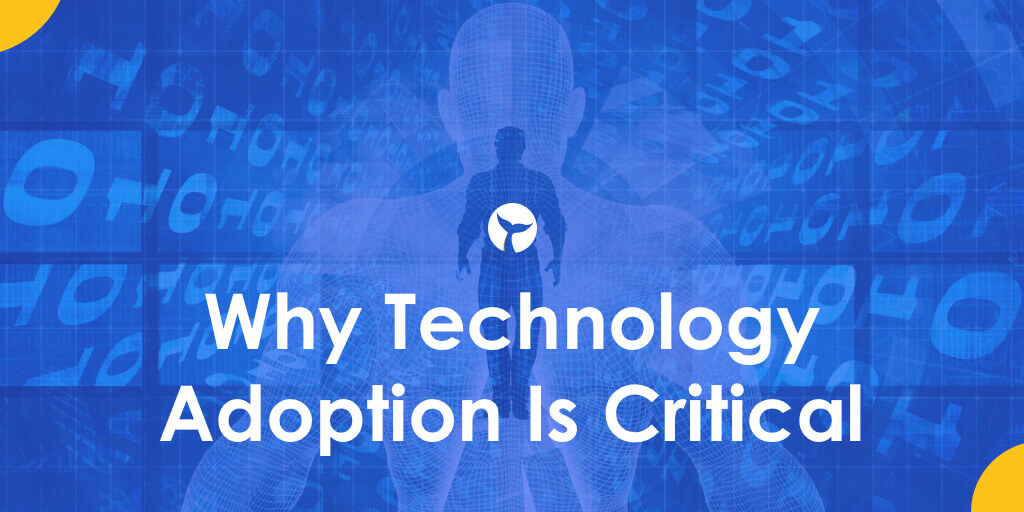Countless organizations have to adopt new technologies to stay ahead of the competition consistently. Whether it applies to a bootstrapped startup or a large corporation, it makes sense that businesses would look to emerging technology trends such as AI, blockchain, and Big Data to stay ahead of the competition.
Let’s take a look at why technology adoption is so important.
What Is Technology Adoption?
What exactly does the business world mean when it talks about “technology adoption”? The answer is quite clear: it refers to how technologies are accepted and adopted. It remains relevant to both employees and consumers, and it can refer to products, apps, websites, software, and more.
Let’s say that you founded a startup with 100 employees. If you are implementing new technology in your organization, technology adoption refers to how quickly your employees understand and begin using that new technology. Of course, technology adoption isn’t just about your employees – it can also apply to consumers, as well.
It’s easy to see how technology adoption has been critical for some of the most powerful tech companies in the world. There was once a time when only a few million people knew about a social media platform called Facebook, but it now boasts over 2 billion monthly active users. Similarly, Apple once had to move through the tech adoption lifecycle before creating some of the most in-demand tech devices in the world.
How Does Technology Adoption Impact Business?

There’s no question that technology adoption can do wonders for the growth and expansion of an existing company. An organization that chooses to digitize its records, for example, can have many positive effects on the way it conducts business. Technology adoption can cut costs, increase productivity, save time, improve the customer experience, and more.
Now, the same company saves money on storage costs and can end up delivering better customer experiences since files are easier to retrieve and access. It can also improve productivity since the typical worker spends an average of 51 minutes per day trying to find files. Here, technology adoption isn’t just about your bottom line: it can help your entire organization become more productive and deliver more value.
There are all sorts of ways technology adoption can impact businesses: it can help them become more agile, cut down on operational costs, personalize customer experiences, and more.
The 5 Customer Segments Of Technology Adoption

The concept of technology adoption has been studied extensively, all around the world. The technology adoption lifecycle was first proposed by Geoffrey Moore, a sociologist who first wrote about it in Crossing The Chasm.
There are five main categories of the technology adoption curve. Here are the categories:
1. Innovators
2. Early Adopters
3. Early Majority
4. Late Majority
5. Laggards
Innovators are the first individuals to embrace new technologies, and they are often young, highly educated, and have access to financial resources that can help them in case the technologies fail. These innovators are often only 2.5% of employees. Innovators are known for being unafraid to take risks.
Early adopters are the group of people that initially begin to see the innovation or potential behind a product. This group includes 13.5% of employees and tends to be younger, middle-class, and higher up in the company hierarchy. Early adopters might not be as interested in risks as the innovators. Still, they might believe the technology can help their career opportunities and also improve the impact of their business.
Next, we have two “majorities” to discuss: the early majority and the late majority. The early majority aren’t focused on innovation but are considered more of the “wait and see” crowd. 34% of employees fall into this category, which often consists of management with above-average social status. By contrast, the late majority includes those who are typically skeptical of new technologies and are usually older. They also make up 34% of employees.
Lastly, there are the laggards. These are the last 16% of employees to embrace technologies. These individuals are interested in tradition rather than innovation, older in age, and usually do not implement new technologies unless forced to utilize them.
How Can My Business Leverage The Technology Adoption Lifecycle?

While it might sound obvious, there’s one major factor to consider: choosing the right technology. Some businesses are eager to choose the “technology of the month,” without truly thinking about the technology, its use cases, and how it offers solutions to that organization’s current problems.
Your business should be able to integrate the technology without completely revamping its business processes. It’s also critical to make sure that the technology is scalable for your specific needs.
With the rise of remote work, the right workflow tools and productivity software can help your organization still feel connected. More workers prioritizing flexibility in their job roles allows your organization to attract top talent. This is another significant benefit of mastering the tech adoption lifecycle.
How to Create A Technology Adoption Strategy That Works
Many businesses turn to all sorts of tools for technology adoption, whether it’s mobile technology, cloud technology, SaaS, or various other technologies. But the question remains: how can you ensure that your employees are using these technologies, even if they are willing to learn them?
One primary step to take to ensure that your technology adoption strategy is effective is to perform a current needs analysis. This is ideal because you can evaluate your needs, budget, options, and a specific time frame for integration. Once you have a concrete plan, you can begin to fill out the other major details of your tech adoption strategy.
There’s another effective strategy that many businesses may want to consider: launching a pilot program. With a pilot program, you can take advantage of a controlled environment to monitor and evaluate how the technology can solve current pain points.
Lastly, communication is critical for successful tech adoption. Your employees have to feel okay about asking questions about technologies, resolving issues, and listening to stakeholder opinions in general. The feedback loop has to be open for your technology adoption strategy to work on all levels.
Boosting New Technology Adoption Rates

What are some simple ways for your business to boost its technology adoption rates? Here are three simple ways to boost tech adoption rates at your organization.
In short, here’s what you can do:
1. Provide a simple but effective onboarding experience
2. Incentivize early adopters
3. Offer ongoing training
One of the most obvious things that any organization can do is make sure that they are providing a comprehensive onboarding experience. It’s also important that the onboarding is versatile enough to appeal to a multi-generational workforce. It should be effective enough to help employees understand and use the technology but simple enough for less tech-savvy employees and/or consumers to understand.
Second, your business should make it clear that early adopters will not only be recognized but incentivized. Your organization should then compile a list of high performers, who can then turn into high-level “evangelists” for the technology and communicate to employees how it helps the organization achieve its mission. The high performers can even turn into future mentors in the organization down the line.
If you want your employees or consumers to be excited about using new technologies, you should offer ongoing training programs. The program should be designed to appeal to as many users as possible, whether it’s an in-person training session or online webinar content. Some employees might be excited about the technology during the initial onboarding, but the excitement can fade over several weeks. The ongoing training can help keep them engaged.






